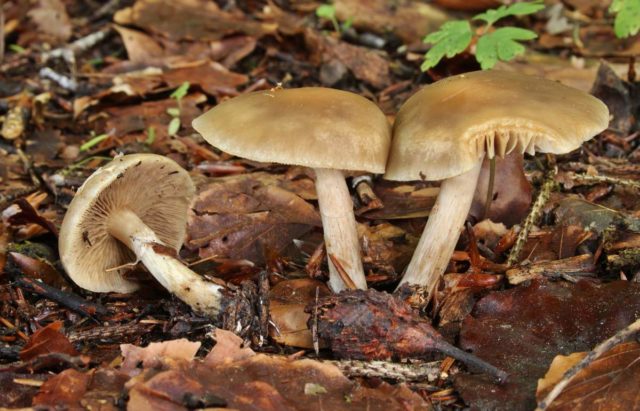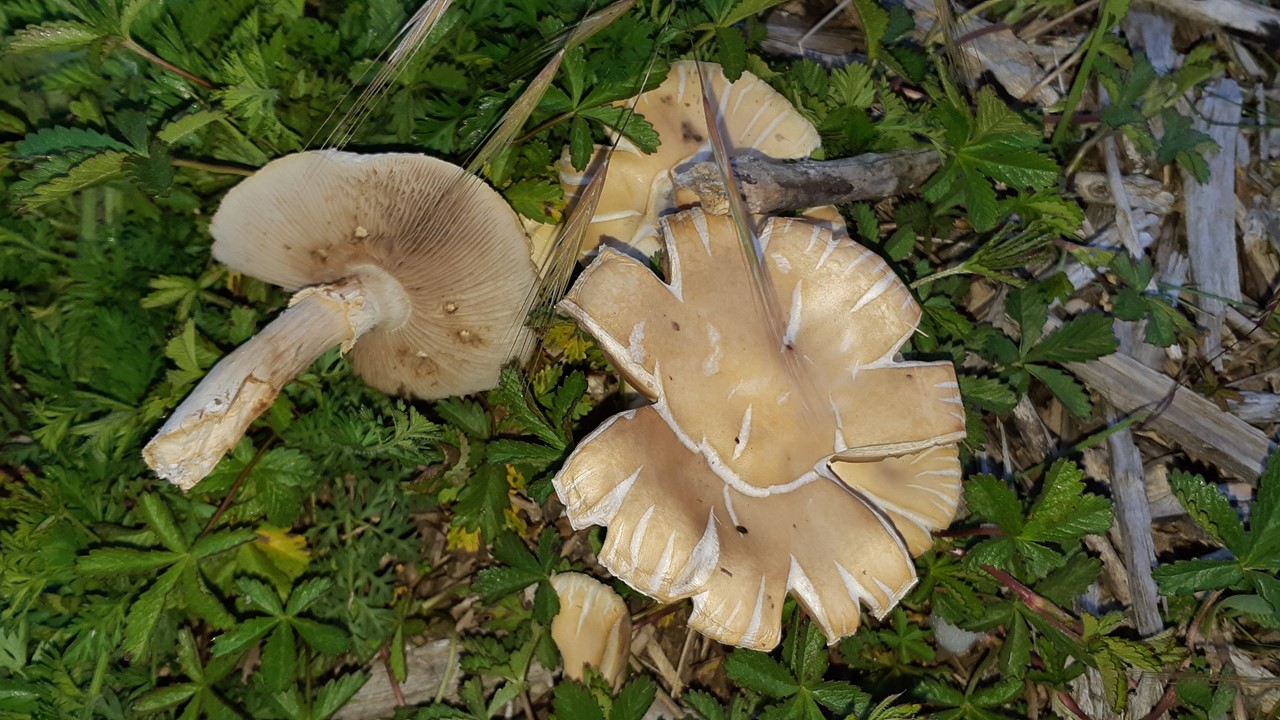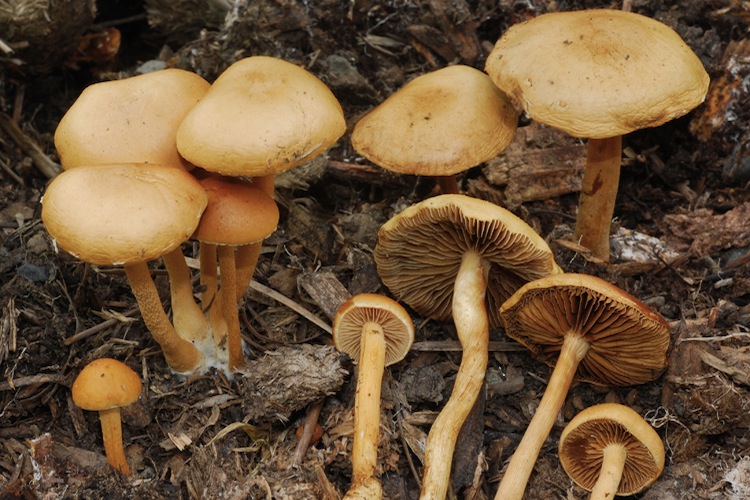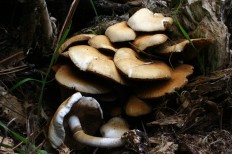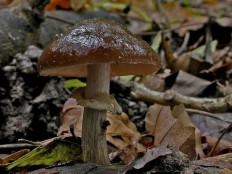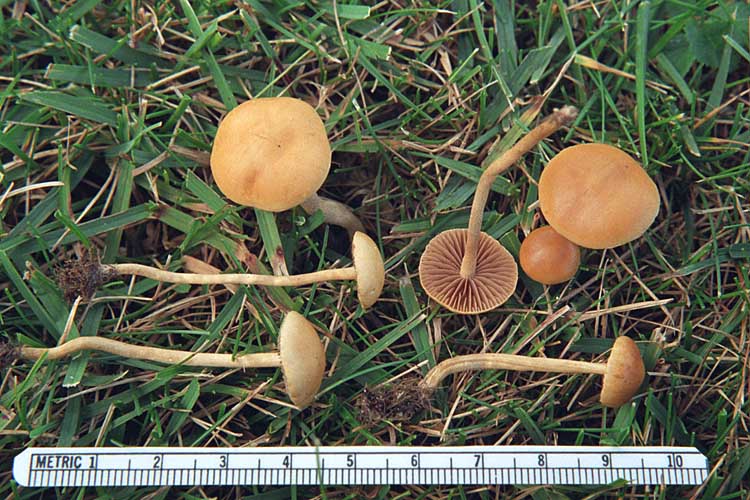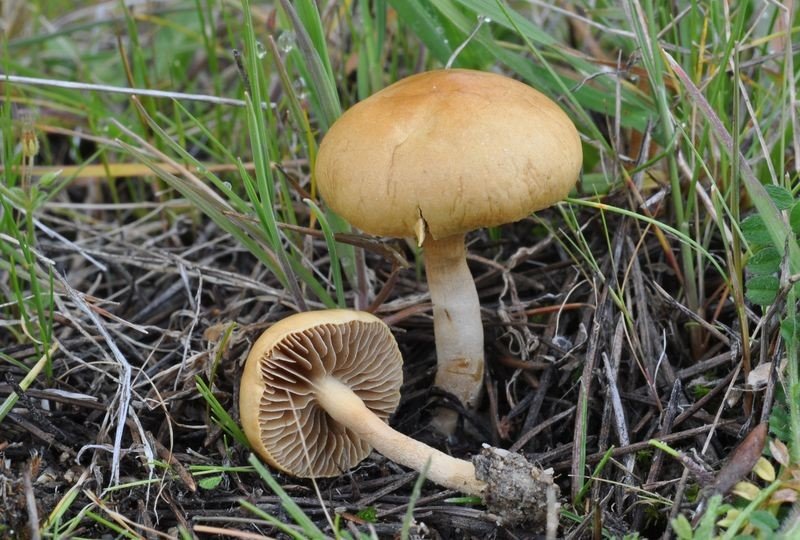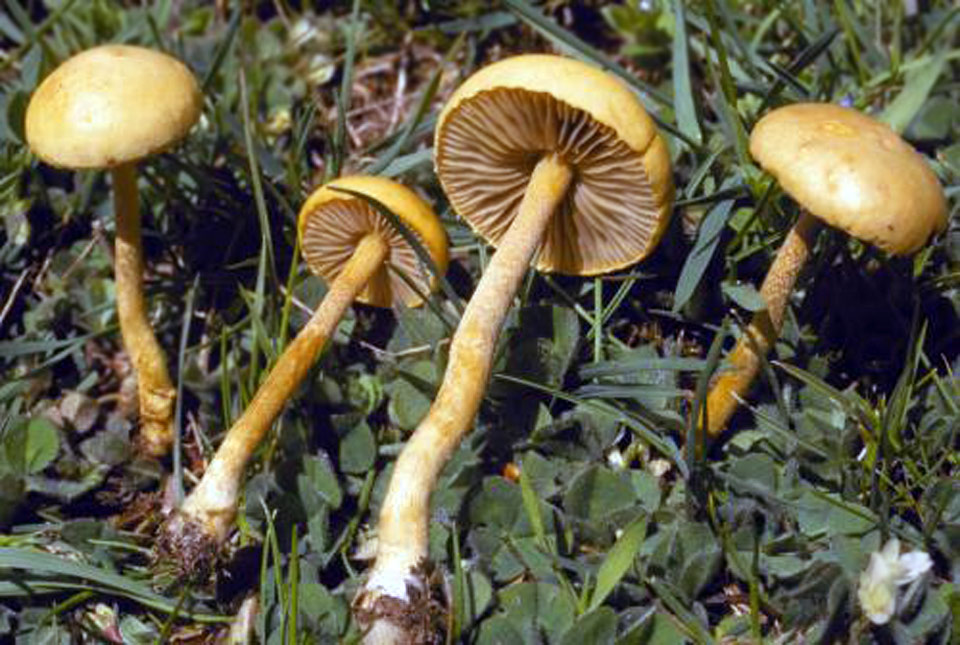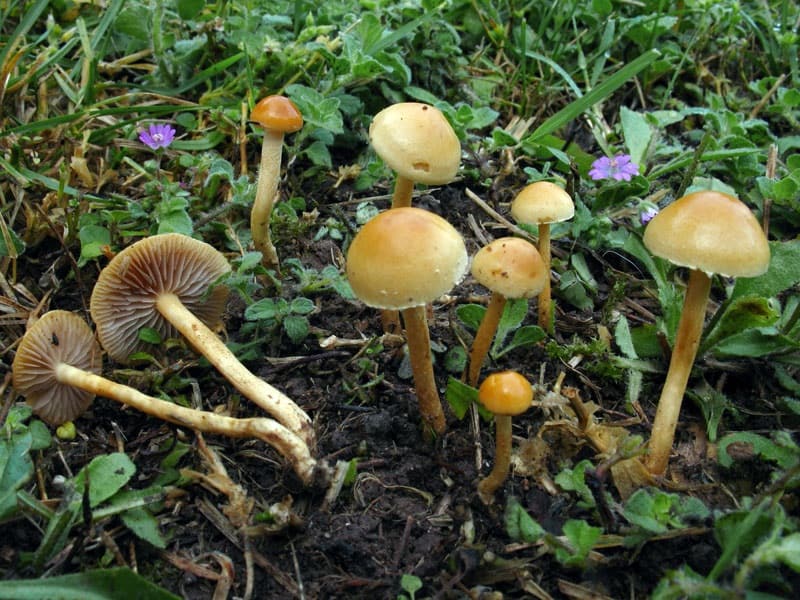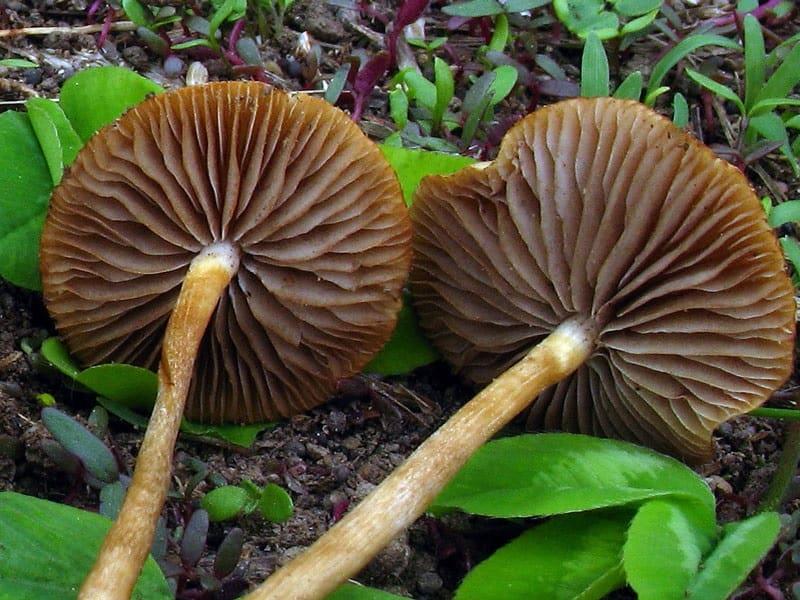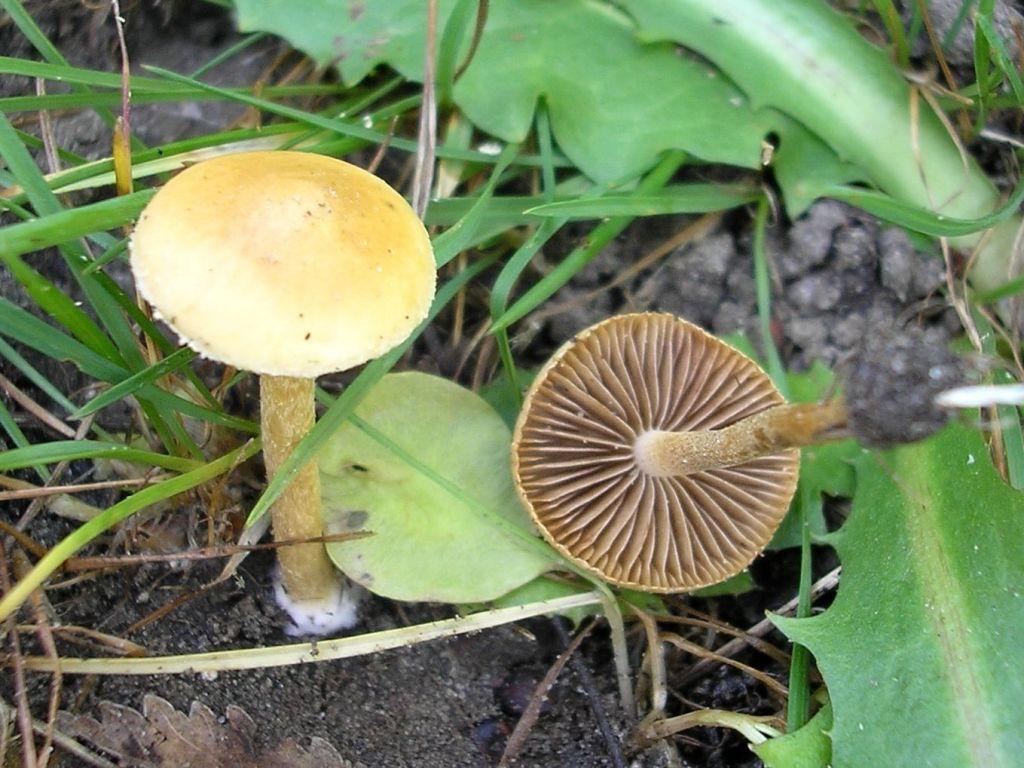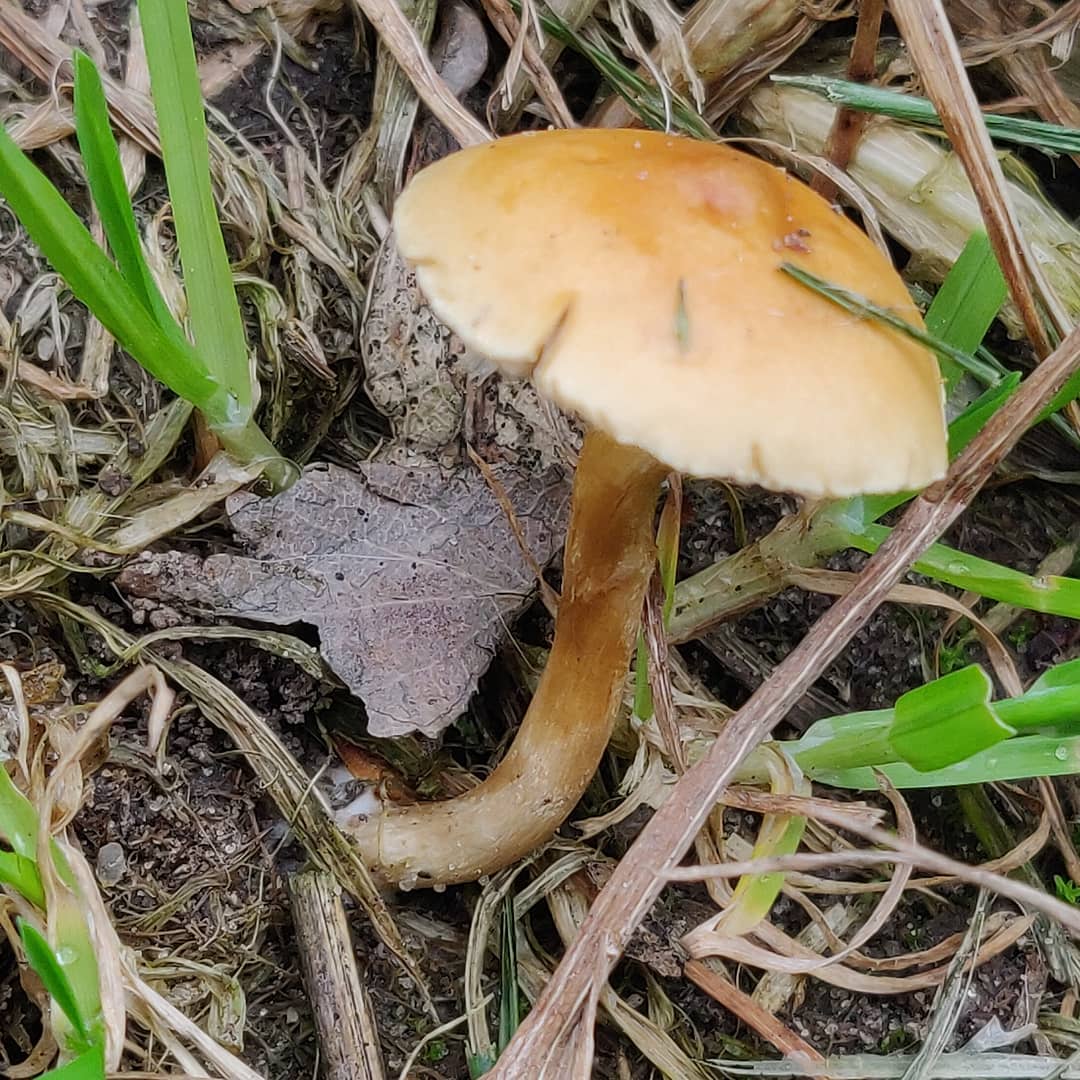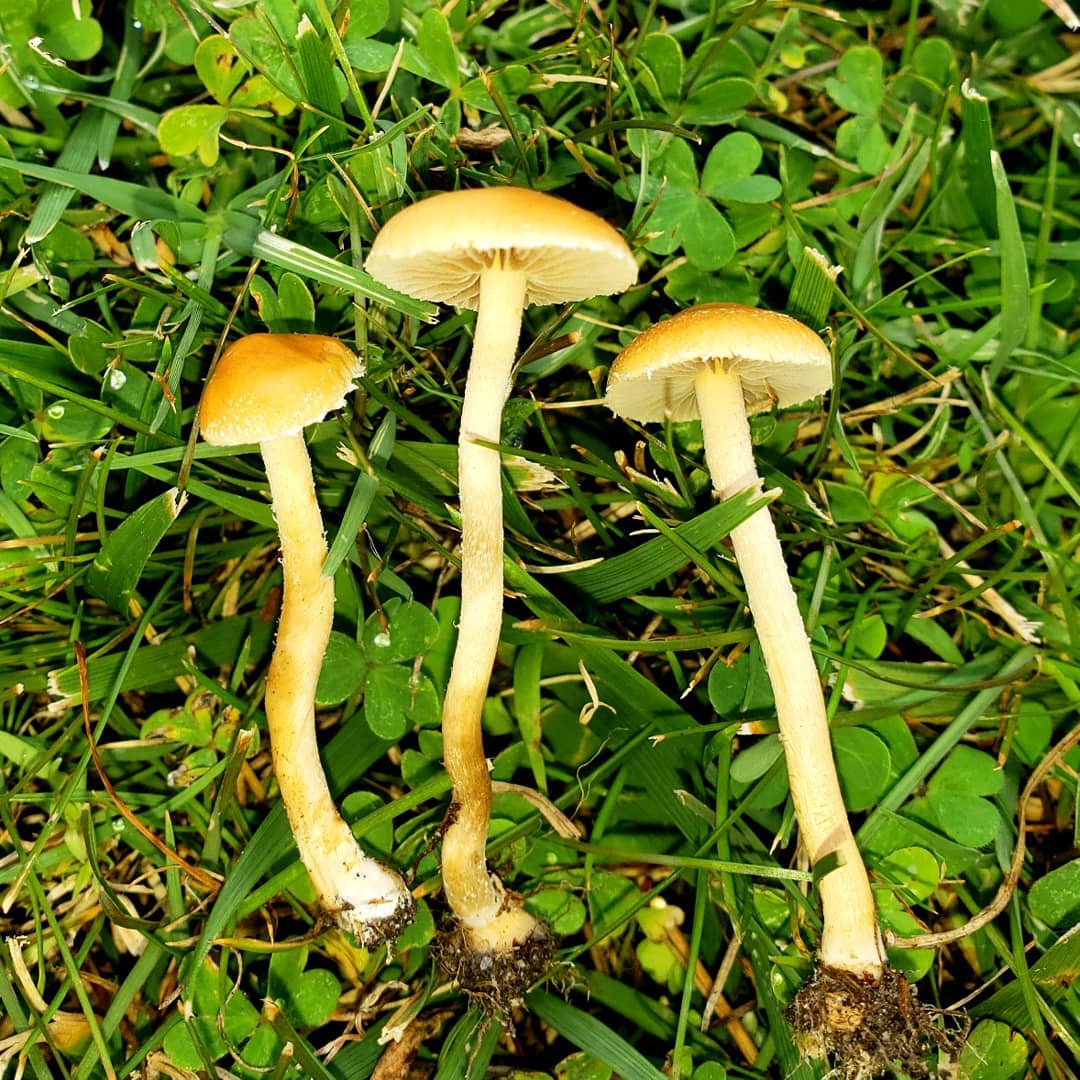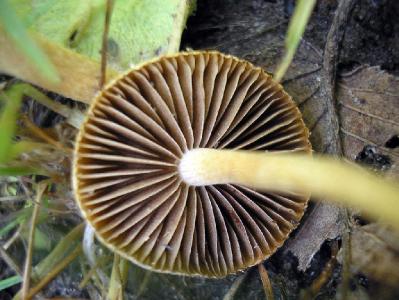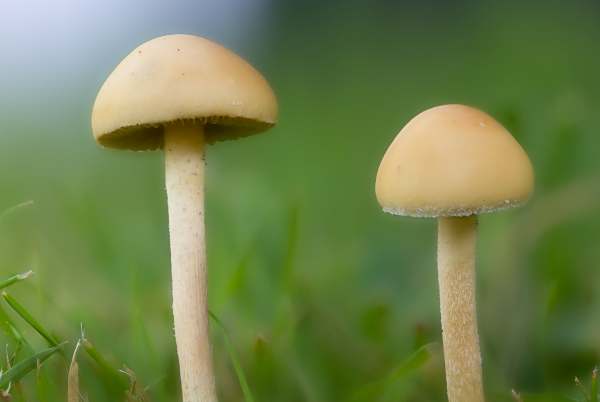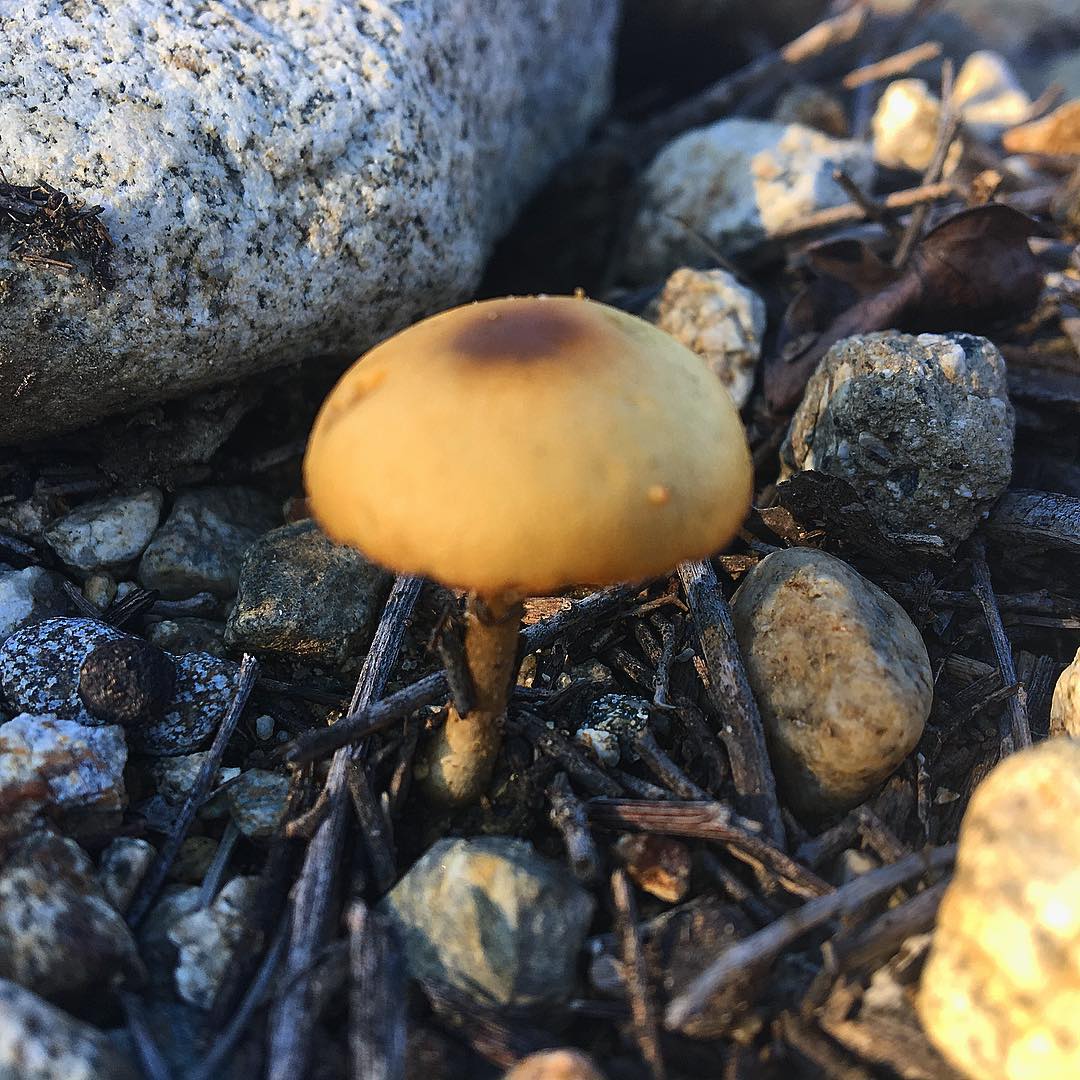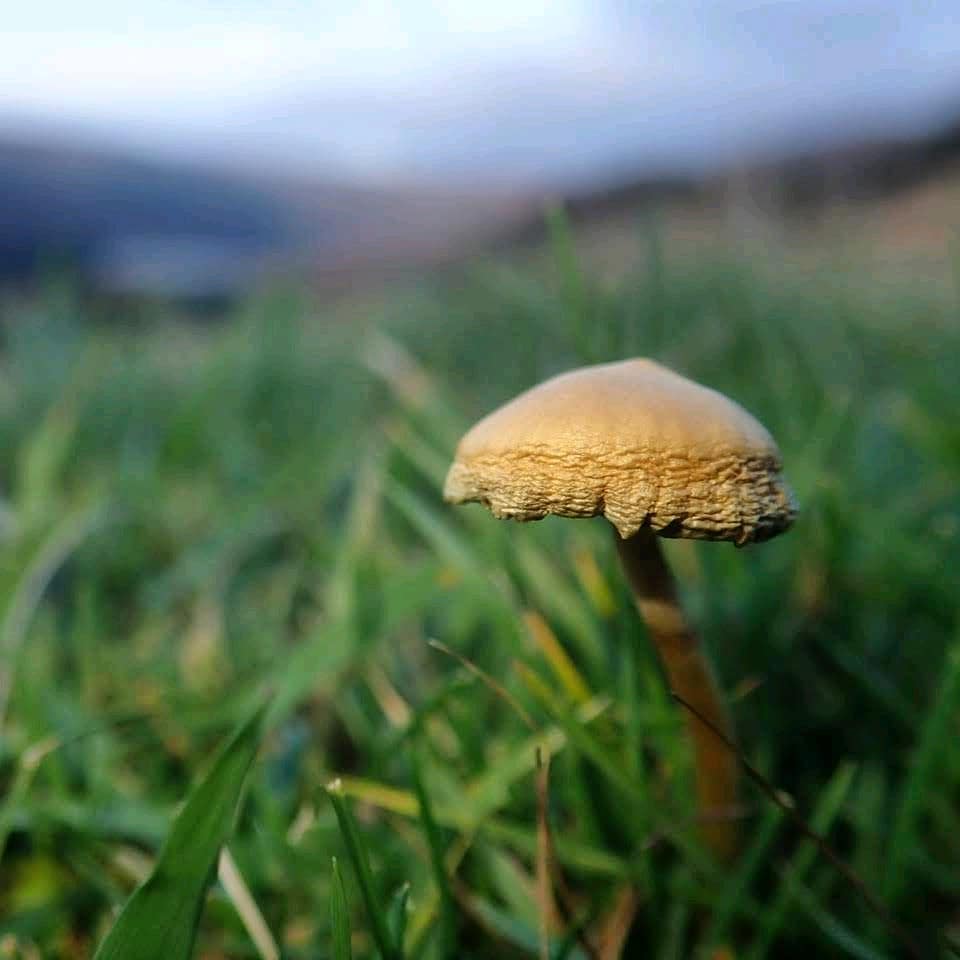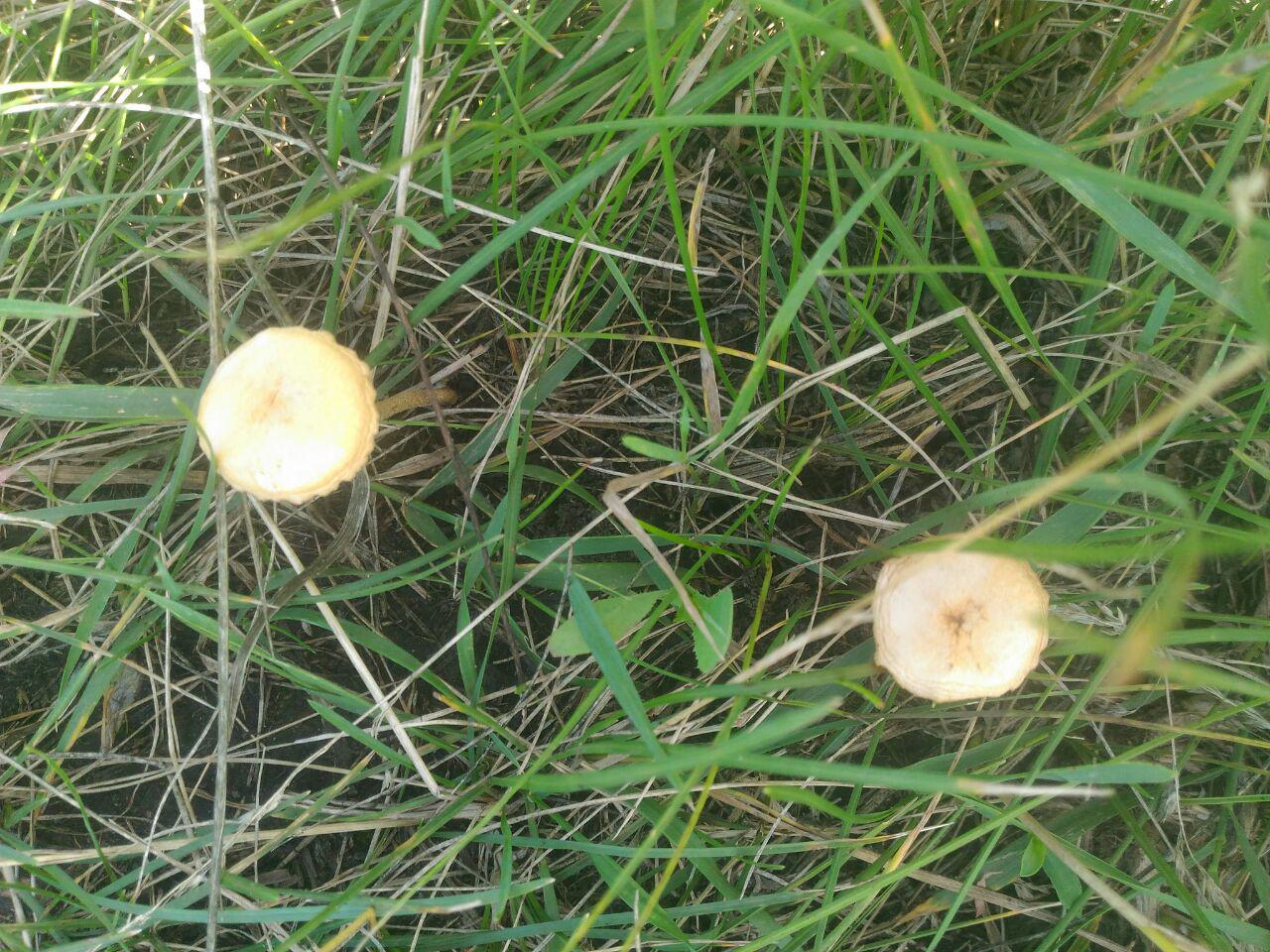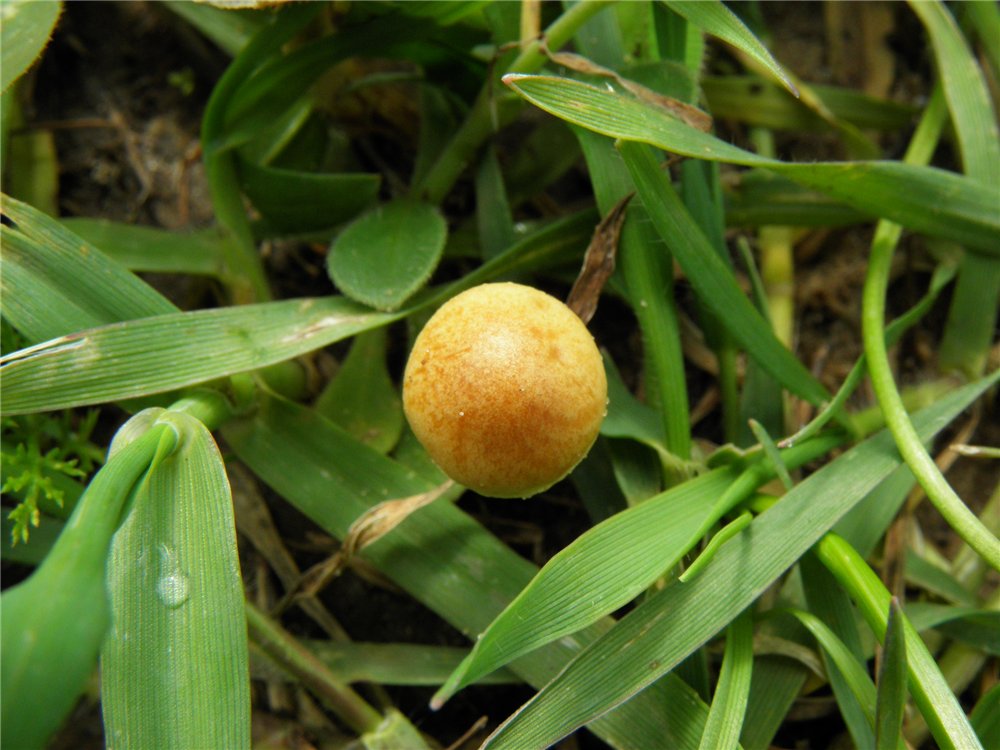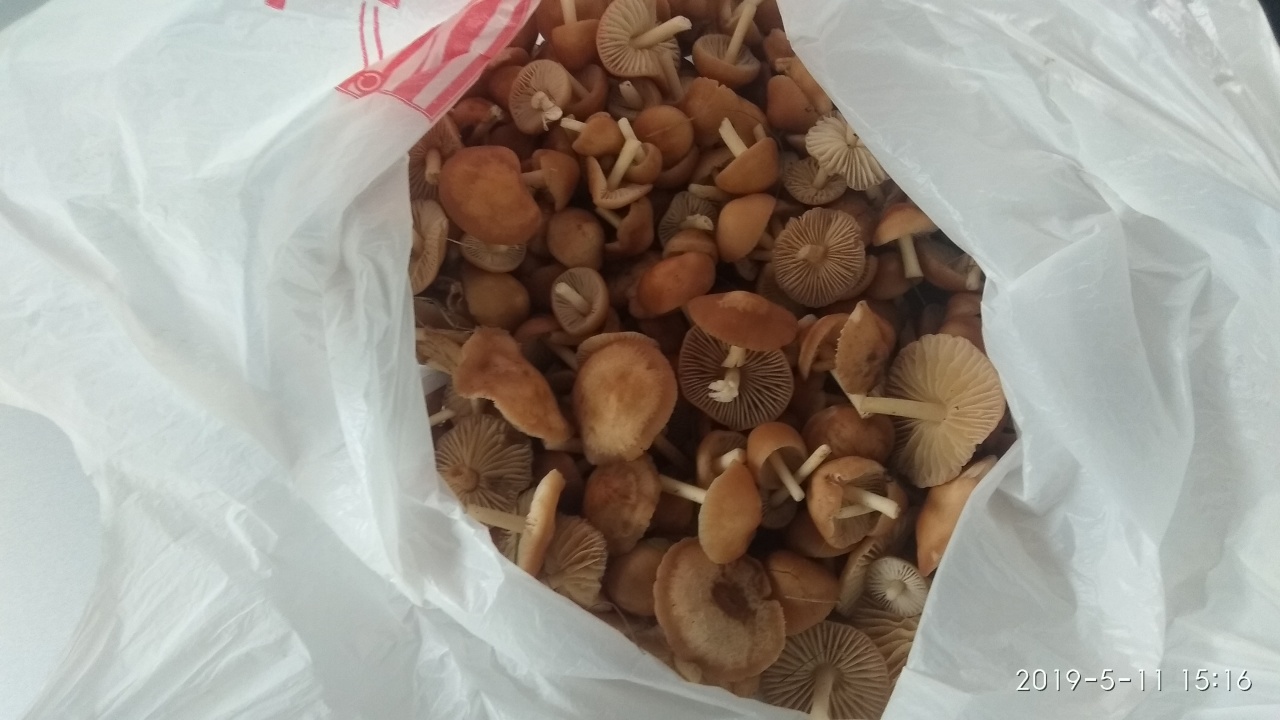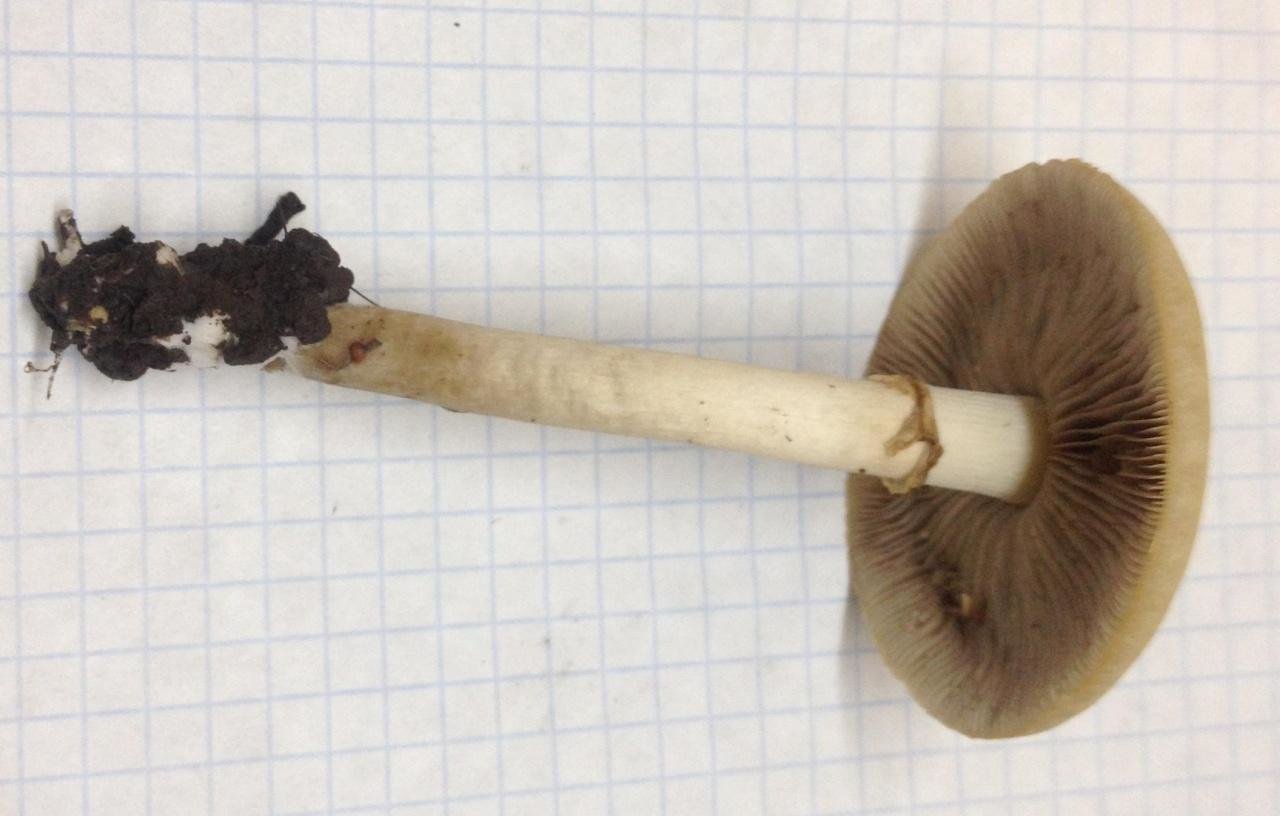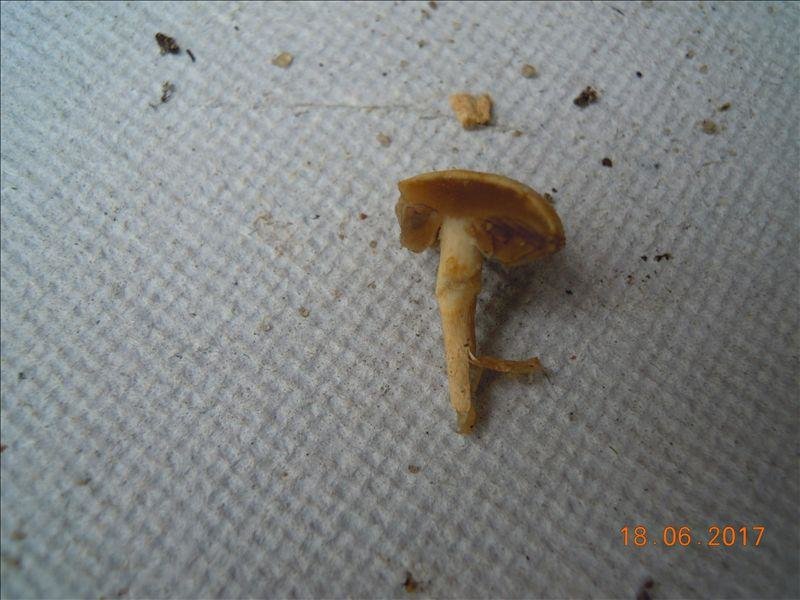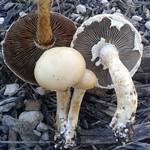Fieldman (Agrocybe)
Agrocybe is a small but vibrant genus that belongs to the Bolbitiaceae family. The Russian name Agrocybe - Polevik - is rarely used; probably because there is no one to apply and there is no time. It cannot be said that ordinary users of the Russian language do not know the mushrooms of this family at all, but it has not yet reached an independent name. Perhaps the reason for this lies in the fact that the "collected" representatives of this genus are ideologically close to champignons (Agaricus), and the others are of little interest besides specialists. And experts are well aware that the genus Agrocybe includes soil saprophytes and xylotrophs, and the latter are abundantly cultivated in the respective countries.
Agrocybe is characterized by a medium size of the fruiting body, a private veil and, most importantly for determining the genus, the tobacco-brown color of the spore powder.
Early polevicAgrocybe praecox
Synonyms: Early flakes Agrocybe early - Russia Polowka wczesna - Poland Spring Agaric - England, UK Agrocybe precoce - France Voreilender Ackerling - Germany
The cap is 3-8 cm wide, in youth it is hemispherical with a distinct “cushion-like pattern”, with age it opens up to spread. The color is vaguely yellowish, light clay, sometimes fading in the sun to a dirty whitish color. In wet weather, faint signs of "zoning" can be found on the cap. The remains of the private bedspread often remain on the edges of the cap, which gives this mushroom a resemblance to representatives of the genus Psathyrella. The flesh of the cap is whitish, thin, with a pleasant mushroom smell. The plates are rather frequent, wide, adherent with a "tooth"; in youth, light, yellowish, with age, as the spores mature, darken to dirty brown. Spore powder, tobacco brown. The leg is the same color as the cap, darker in the lower part. The stem is hollow, but at the same time very stiff and fibrous. Height 5-8 cm, in the grass it can be higher; thickness up to 1 cm, although usually thinner. In the upper part, the remains of the ring, as a rule, are somewhat darker than the stem itself (they become even darker when the mushroom matures, being decorated with falling spores). The flesh is brownish, especially at the bottom.
Distribution: Occurs from early June to mid-July in gardens, parks, along the edges of forest roads, preferring rich soils; can settle on strongly rotted wood remains. In some seasons, it can bear fruit very abundantly, although it usually comes across less often.
Similar species: Given the timing of growth, it is rather difficult to confuse the early vole with any other fungus. Closely related and outwardly similar species (such as, for example, Agrocybe elatella) are much less common.
Edible: Normal edible mushroom, although some sources indicate bitterness.
In the collector's understanding, Agrocybe praecox is a kind of “unfinished champignon”. Growing conditions, discs darkening with age, strong dependence of size and weight on soil fertility - all this gives the right to treat this field as a champignon for the poor and hasty. Having met an old woman in the forest with a basket of selected agrocybians, I asked what she was collecting. “Why, chamignons, we eat them every year,” she replied. Inspired by this example, I also recruited early agrocytes and treated my friends. Champignons for ourselves and champignons, if you do not go into details, except for our brother, are of little interest to anyone.
Agrocybe erebiaAgrocybe erebia
The hat is 5-7 cm in diameter, at first bell-shaped, sticky, dark brown, brown-chestnut, with a fawn veil, then prostrate, flat, with a wavy-lobed edge, light brown or brown, smooth, shiny, with a raised wrinkled edge. Plates: frequent, adherent with a tooth, sometimes inversely forked, light, then leathery with a light edge. The spore powder is brown. Leg: 5-7 long and about 1 cm in diameter, slightly swollen or fusiform, longitudinally fibrous, with a ring, with a granular bloom above it, striped below. The ring is thin, bent or pendant, striped, gray-brownish.The pulp is thin, cotton-like, pale yellow, grayish-brownish, with a fruity odor. It is considered a conditionally edible mushroom.
Distribution: from the second half of June to autumn, in mixed and deciduous forests (with birch), at the edge of the forest, outside the forest, near roads, in parks, in grass and on bare soil, in groups, rarely.
Link to article for posting on sites
Views
- Agrocybe acericola (Peck) Singer, 1950
- Agrocybe allocystis Singer, 1969
- Agrocybe apepla Singer, 1978
- Agrocybe arvalis (Fr.) Singer, 1936 - Field vole
- Agrocybe attenuata (Kühner) P.D. Orton, 1960
- Agrocybe bokotensis (Beeli) Watling, 1973
- Agrocybe broadwayi (Murrill) Dennis, 1953
- Agrocybe brunneola (Fr.) Bon, 1980
- Agrocybe calicutensis K.A. Thomas & Manim., 2003
- Agrocybe carneobrunnea Watling, 1973
- Agrocybe collybiiformis (Murrill) Singer, 1951
- Agrocybe coprophila Singer, 1945
- Agrocybe cubensis (Murrill) Singer, 1978
- Agrocybe cylindracea (DC.) Gillet, 1874 - Cylindrical vole
- Agrocybe dura (Bolton) Singer, 1936 - Hard vole
- Agrocybe earlei (Murrill) Dennis ex Singer, 1978
- Agrocybe erebia (Fr.) Kühner ex Singer, 1939
- Agrocybe fimicola (Speg.) Singer, 1950
- Agrocybe firma (Peck) Singer, 1940
- Agrocybe guruvayoorensis K.A. Thomas & Manim., 2003
- Agrocybe howeverana (Peck) Singer, 1951
- Agrocybe hortensis (Burt) Singer, 1978
- Agrocybe illicita (Peck) Watling, 1977
- Agrocybe insignis Singer, 1941
- Agrocybe lenticeps (Peck) Singer, 1973
- Agrocybe microspora Singer, 1978
- Agrocybe molesta (Lasch) Singer, 1978 - Unpleasant vole
- Agrocybe munnarensis K.A. Thomas & Manim., 2003
- Agrocybe neocoprophila Singer, 1953
- Agrocybe olivacea Watling & G.M. Taylor, 1987
- Agrocybe paludosa (J.E. Lange) Kühner & Romagn. ex Bon, 1987 - Marsh vole
- Agrocybe paradoxa Singer, 1973
- Agrocybe parasitica G. Stev., 1982
- Agrocybe pediades (Fr.) Fayod, 1889 - Stop vole
- Agrocybe platysperma (Peck) Singer, 1973
- Agrocybe praecox (Pers.) Fayod, 1889 - Early vole
- Agrocybe procera Singer, 1969
- Agrocybe pruinatipes (Peck) Watling, 1977
- Agrocybe puiggarii (Speg.) Singer, 1952
- Agrocybe pusiola (Fr.) R. Heim, 1934
- Agrocybe putaminum (Maire) Singer, 1936
- Agrocybe retigera (Speg.) Singer, 1951
- Agrocybe rivulosa Nauta, 2003
- Agrocybe sacchari (Murrill) Dennis, 1953
- Agrocybe sororia (Peck) Watling, 1978
- Agrocybe tucumana (Singer) Watling, 1981
- Agrocybe underwoodii (Murrill) Singer, 1962
- Agrocybe vervacti (Fr.) Singer, 1936
- Agrocybe viscosa Singer, 1969
- Agrocybe xerophytica Singer, 1959
- Agrocybe xuchilensis (Murrill) Singer, 1958
Views
- Agrocybe acericola (Peck) Singer, 1950
- Agrocybe allocystis Singer, 1969
- Agrocybe apepla Singer, 1978
- Agrocybe arvalis (Fr.) Singer, 1936 - Field vole
- Agrocybe attenuata (Kühner) P.D. Orton, 1960
- Agrocybe bokotensis (Beeli) Watling, 1973
- Agrocybe broadwayi (Murrill) Dennis, 1953
- Agrocybe brunneola (Fr.) Bon, 1980
- Agrocybe calicutensis K.A. Thomas & Manim., 2003
- Agrocybe carneobrunnea Watling, 1973
- Agrocybe collybiiformis (Murrill) Singer, 1951
- Agrocybe coprophila Singer, 1945
- Agrocybe cubensis (Murrill) Singer, 1978
- Agrocybe cylindracea (DC.) Gillet, 1874 - Cylindrical vole
- Agrocybe dura (Bolton) Singer, 1936 - Hard vole
- Agrocybe earlei (Murrill) Dennis ex Singer, 1978
- Agrocybe erebia (Fr.) Kühner ex Singer, 1939
- Agrocybe fimicola (Speg.) Singer, 1950
- Agrocybe firma (Peck) Singer, 1940
- Agrocybe guruvayoorensis K.A. Thomas & Manim., 2003
- Agrocybe howeverana (Peck) Singer, 1951
- Agrocybe hortensis (Burt) Singer, 1978
- Agrocybe illicita (Peck) Watling, 1977
- Agrocybe insignis Singer, 1941
- Agrocybe lenticeps (Peck) Singer, 1973
- Agrocybe microspora Singer, 1978
- Agrocybe molesta (Lasch) Singer, 1978 - Unpleasant vole
- Agrocybe munnarensis K.A. Thomas & Manim., 2003
- Agrocybe neocoprophila Singer, 1953
- Agrocybe olivacea Watling & G.M. Taylor, 1987
- Agrocybe paludosa (J.E. Lange) Kühner & Romagn. ex Bon, 1987 - Marsh vole
- Agrocybe paradoxa Singer, 1973
- Agrocybe parasitica G. Stev., 1982
- Agrocybe pediades (Fr.) Fayod, 1889 - Stop vole
- Agrocybe platysperma (Peck) Singer, 1973
- Agrocybe praecox (Pers.) Fayod, 1889 - Early vole
- Agrocybe procera Singer, 1969
- Agrocybe pruinatipes (Peck) Watling, 1977
- Agrocybe puiggarii (Speg.) Singer, 1952
- Agrocybe pusiola (Fr.) R. Heim, 1934
- Agrocybe putaminum (Maire) Singer, 1936
- Agrocybe retigera (Speg.) Singer, 1951
- Agrocybe rivulosa Nauta, 2003
- Agrocybe sacchari (Murrill) Dennis, 1953
- Agrocybe sororia (Peck) Watling, 1978
- Agrocybe tucumana (Singer) Watling, 1981
- Agrocybe underwoodii (Murrill) Singer, 1962
- Agrocybe vervacti (Fr.) Singer, 1936
- Agrocybe viscosa Singer, 1969
- Agrocybe xerophytica Singer, 1959
- Agrocybe xuchilensis (Murrill) Singer, 1958
Gray lamellar honey fungus: where false mushrooms grow
Seroplate false honey fungus belongs to the conditionally edible group of mushrooms and belongs to the Stropharia family. Its Latin name is Hypholoma capnoides. Mushroom pickers are also called poppy or pine false foams.
Description of seroplate pseudo-foam
The cap of this type of mushroom has a diameter of 2-8 cm. Its color depends on the moisture and age of the mushroom body: in dry mushrooms it is light yellow with a rich center, in wet mushrooms it is light brown. There is a whitish film on the plates.
In adult mushrooms, the cap evens out, and its shade changes to orange-brown with dark blotches. At the same time, the film breaks down and hangs on the body in the form of whitish flakes. In wet weather, the surface of the cap becomes sticky.
Gray-lamellar pseudo-foam can have a straight or slightly curved stem, on which there are practically no rings. Its upper part is colored light yellow, and the lower part is brown.
The flesh of the mushroom cap is thin, white or light yellow, almost odorless. However, old mushroom bodies are distinguished by a pronounced odor of moisture. Spores are gray-blue in color.
Where grow
Most often, gray mushrooms are found in the Northern Hemisphere, in regions with a temperate climate. They grow in forests with conifers, but sometimes they can also be seen in mixed woodlands. Among deciduous trees, poppy pseudo-froth rarely grows.
In most cases, these fungal bodies are found on tree stumps, rotting tree trunks and roots in lowlands and hills. Mushroom pickers collect them from early summer to late autumn, but the peak of ripening of fruit bodies occurs in September-October. False heaps prefer to settle in large clusters, single fruiting bodies rarely grow.
Some varieties of fungi form a symbiosis (mycorrhiza) with plants, and the gray-lamellar type pseudo-weavers act as symbiotes. Their myceliums go deeper into the root system of plants and provide constant nutrition to the fungal bodies.
For plants, this union is also useful, since the roots of false hoofs deliver minerals from the soil to their rhizomes. As a result, the pines grow tall and powerful. However, if gray mushrooms grow on unhealthy trees, then the latter die.
How do they reproduce
Like other types of mushrooms, gray-lamellar mushrooms reproduce through spores and have a smooth surface and an elongated shape. The spore powder has a deep purple or gray-blue color.
Disputes are recorded on the plates. They spread over the terrain with the help of the wind. After the spore hits the surface of the earth, it begins to actively form mycelium.
Edibility of honey fungus
Sulfur-lamellar mushrooms are considered conditionally edible. Most of the mushrooms in the Strophariacea family are poisonous, but some types, including the gray puffins, can be used as food, but only after careful processing.
To taste, this subspecies belongs to the fourth category. False foam is added to various culinary dishes, but before that it must be boiled for 15 minutes. At the same time, mushroom bodies can be dried, pickled and made on their basis mouth-watering pickles. Gray honey mushroom is characterized by a pleasant and mild taste and aroma.
It is advisable to eat young fruiting bodies for food, because old mushrooms have an unpleasant odor. In this case, it is recommended to collect only the caps of the mushrooms, since their legs are too hard.
Similar species
This type of mushroom can be confused with other members of the Gifoloma genus. Most similar species:
- Brick red false froth. This mushroom got this name for its specific color. The fruit body is not poisonous, however, it is not customary to eat it. The peculiarity of the brick-red variety is that its plates are yellow in color. The pulp is dense and bitter in taste, so dishes made from brick-red honey mushrooms are not particularly appetizing.
When collecting seroplate false mushrooms, you should exercise maximum vigilance, because eating poisonous mushrooms similar to it can lead to extremely undesirable health effects.
Edibility of the cylindrical vole
It is an edible mushroom and is highly prized in Western countries. These edible mushrooms are very popular in Southern Europe, where they are widely used for food. They are grown artificially. Cylindrical voles are most popular in the south of France, where they are considered one of the best mushrooms and are part of the Mediterranean culinary culture.
Cylindrical voles are used to prepare sauces for pork, corn porridge, and sausages. They are suitable for drying, pickling and canning.
In folk medicine, these mushrooms are not used.

Similar species
The cylindrical vole can be confused with a ringed cap. It is also an edible mushroom of high quality, growing in deciduous and spruce forests in groups.
The diameter of the cap of the ringed cap ranges from 5 to 15 centimeters. The cap is fleshy, cap-shaped, with edges curled downwards. The color of the cap is straw-yellow, gray-yellow or ocher. The cap is striped along the edge. As it grows, the cap straightens out and becomes flat, while the central part rises. The surface of the cap is wrinkled, covered with a fibrous light bloom with a pearly sheen. In dry weather, the edges of the cap crack.

The flesh of the ringed cap is soft, friable, white, later it turns yellow. The color and smell of the pulp is pleasant. The leg is strong, cylindrical, thicker at the base. The leg structure is solid. Its length ranges from 4 to 12 centimeters, and its thickness is 1-3 centimeters. There is a ring on the leg, the surface above the ring is slightly scaly, covered with flakes, yellowish, and under the ring - light ocher color. Spores are warty, ocher. Rusty brown spore powder.
Ringed caps form mycorrhiza mainly with coniferous trees, but also with birch, oak and beech. In the middle lane, these fungi grow in mossy places, giving preference to acidic moist soils. They can be found in the mountains at an altitude of up to 2 thousand meters.They are widespread in Western Europe, Belarus, and in the European part of Russia. The fruiting season is from July to October.
These delicious mushrooms can be cooked in a variety of ways: fry, salt, pickle. Ringed caps are not inferior to champignons to taste. The best taste is inherent in young specimens. The stem hardens early, so the stiff legs are removed if necessary.

Agrocybe stop-like: where it grows and what it looks like, edibility
| Name: | Agrocybe stop-shaped |
| Latin name: | Agrocybe pediades |
| Type of: | Inedible |
| Synonyms: | Stop vole, Stop vole, Pholiota semiorbicularis, Agrocybe semiorbicularis. |
| Systematics: |
|
Agrocybe stop-shaped is an inedible representative of the Strofariev family. Grows in open areas, clearings and meadows. Fruiting from May to October. Since the mushroom is not used in cooking, you need to know a detailed description, view photos and videos.
Where does the agrocybe grow
Agrocybe stop-like prefers to grow in meadows, pastures, in mountainous and hilly places. Fruiting during the entire warm period, singly or in small families. Since the species is widespread in Russian forests and is not used in cooking, you need to study external data, view photos and know similar twins.
What does an agrocybe look like?
A thin, fragile cap at the beginning of growth has a hemispherical shape. As it grows older, it straightens out, leaving a small bump in the center. The surface is smooth, wrinkled, light coffee or ocher in color. On a rainy day, a slimy layer appears on the cap.
The lower layer is formed by rare, wide plates not covered with a dense film. In young species, they are light yellow; as they mature, they become brown-brown. A thin, long leg, painted to match the cap, is covered with a whitish bloom. The pulp is thin, loose, has a mealy taste and smell. On the cut, the color does not change, the milky juice does not stand out.
Reproduction occurs by elongated spores, which are located in dark coffee powder.
Grows singly or in small families
Is it possible to eat a stop agrocybe
Agrocybe stop-like is an inedible, but not toxic forest dweller. Causes mild eating disorder when eaten. When the first signs appear, you need to provide first aid in a timely manner. Poisoning symptoms:
- nausea, vomiting;
- epigastric pain;
- diarrhea;
- cold sweat;
- lacrimation;
- headache.
To stop the absorption of toxins into the bloodstream, you first need to flush the stomach. For this, the victim is given a large amount of a light pink solution of potassium permanganate.
Inedible representatives are dangerous to children, the elderly and pregnant women. Due to the reduced immunity, the signs of intoxication appear faster and are much brighter.
Since the agrocybe stopoid has similar counterparts, you need to know their external description and view the photo. Doubles of this representative of the forest kingdom:
- Early field vole is an edible specimen with a small, fragile cap, light lemon color. A thin, long leg is painted in darker tones and has remnants of a film blanket. The fragile pulp has a mushroom flavor and aroma. This forest dweller grows in large families, on rotten wood. Abundant fruiting occurs from June to August. After a long boiling, they are used to prepare fried, stewed and canned dishes.
Used in cooking fried and canned
Prefers to grow in full sun during the whole warm period
The hemispherical cap partially straightens when fully ripe
Conclusion
Agrocybe stop-shaped - inedible species, when eaten causes stomach upset. Grows in open areas in tall grass. In order not to harm yourself and your loved ones, you need to know a detailed description of the cap and legs, as well as the time and place of growth. Experienced mushroom pickers recommend, when an unknown specimen is found, not to pluck it, but to walk by.
(gyroporus)
✎ Affiliation and generic features
Gyropor or gyroporus (lat.Gyroporus) is a genus of mushrooms of the gyroporic family (lat.Gyroporaceae) and a large order of boletus (lat.boletales). The family of gyropores (lat.Gyroporaceae) is monotypic (a group containing one directly subordinate taxon) and contains a single genus Gyroporus, which, according to recent studies (from 2008), collects only a dozen species in all. The genus of gyropores is a very narrow genus of fungi and unites no more than 10 species that live in the temperate zone of the Northern Hemisphere, sometimes in the tropics. On the territory of Russia, only 3 of them are considered the most famous, and these are:
and only the first 2 are significant for mushroom pickers, since the third species is toxic, weakly poisonous, although until recently it was a common variety of edible chestnut gyropore (lat.Gyroporus castaneus).
Gyropores are extremely rare edible (like chestnut gyropore) and conditionally edible (like birch gyropore) species included in the Red Book of Russia, forming mycorrhiza with very many broad-leaved species (oaks, beech trees, ash trees, elms, maples, linden trees, chestnuts), and sometimes with conifers (pines).
✎ Similar appearance and nutritional value
Gyropores, in addition to being similar to some edible mushrooms, can also resemble inedible ones. Gyropors have such a double, and this is a gall mushroom from the genus Tolopil (tolopilus), with which they are united by the bitter taste of pulp, but distinguishes between a hollow, or with voids inside, a leg, as well as a pulp that turns blue at a break. At the same time, it should be noted that gyropores have no similarities with poisonous species. In terms of nutritional quality and nutritional value, gyropore mushrooms are edible, or conditionally edible, mushrooms of the second category. Gyropores, due to their rare prevalence, are recognized as very desirable, and in the gastronomic plan - delicious mushrooms. So, any mushroom picker will be happy to find them, and any culinary specialist (with caution, but with pleasure) will prepare an obvious masterpiece from them. But it is worth considering that gyropores are listed in the Red Book of Russia and their collection is pure poaching.
✎ Distribution in nature and seasonality
Gyropores usually prefer mixed broad-leaved or pine-oak forests, and they always choose not dense, lighted and dry areas. At the same time, they do not like to climb deep into the forest, but settle along the forest edges. Most likely, gyropores are widespread in Western and Eastern Europe, very rich in broad-leaved trees and are found mainly in the southern regions from France to the Far East, but everywhere they are extremely rare. On the territory of Russia, gyropore fungi are found even less often (in the temperate zone), where there are broad-leaved forests. And these are the western, southwestern outskirts of the country, the south of the European part, the Caucasus, partly Western Siberia and the Far East. Gyropores do not bear fruit for a long time, usually from late July - early August to mid or late September.
✎ Brief description and application
Gyropores are common representatives of the section of tubular fungi and the inner zone of their cap has a porous structure. The tubules of the hymenophore (spore-bearing layer) of the gyropores are pale yellowish or coral-chalk in color. The caps of young fruits are very dense and fleshy, colored from light chestnut and orange-brown to reddish-brown, noticeably dry and velvety, or smooth to the touch. Legs without a mesh pattern, loose, in ripe fruits with voids inside or hollow.The flesh in the cap is dense, elastic, loose in the stem, white in color, and on the cut at the birch (blue) gyropore it sharply changes color, and does not change the chestnut color in the chestnut gyropore.
Different gyropore mushrooms are also cooked in different ways. Some of them (chestnut mushrooms), when boiled, are slightly bitter and therefore they are usually dried or fried raw, but not salted or pickled, because their brine tastes bitter and spoils the dish. Others (podduboviki) can be used "raw", without prior boiling, in frying, salting, pickling, drying or in the preparation of mushroom sauces.
Instructions for growing mushroom agrocybe (erebia)

Growing mushrooms on plant residues (intensive method)
Agrocybe grows in abundance on wood chips, often forming a large drusen, both naturally and under controlled industrial cultivation.
This fungus places very high demands on the microbiological purity of the substrate components. The raw materials must be the freshest. Even traces of mold or bacterial contamination are unacceptable.
The composition of the substrate should include: base - sawdust, straw, etc., a nutritional supplement is required - soy flour, bran, etc., as well as a mineral additive - lime, chalk, gypsum.
The pre-moistened substrate is placed in heat-resistant containers and sterilized. After the sterile blocks have cooled, they are inoculated with agrocybe mycelium under sterile conditions and remain in these conditions until the block is completely overgrown. The optimum temperature during overgrowth is 21-27 ° C.
After the block is completely and evenly overgrown, it is necessary to make small cross-shaped cuts on it, through which mushrooms will grow or open the upper part of the container.
At a young age, mushrooms are dark brown, almost black in color. The optimum air temperature during fruiting is 15-18 ° C, humidity 90-95%.
Overripe mushrooms throw out brown spores, the edges of the caps crack.
Agrocybe extracts nutrients directly from the top layer of the mycelium. That, in turn, is sensitive to the ingress of condensate (fog) on the surface. If it is not possible to avoid this effect, the use of casing layer is justified. The commercial mushroom has a pleasant aroma and dense texture.
Agrocybe erebia

Agrocybe erebia (Latin Agrocybe erebia) is a conditionally edible lamellar mushroom from the Strophariaceae family.
Quite often, amateurs of collecting various mushrooms cannot always accurately identify their individual varieties, since they do not have the necessary deep knowledge. That is why if an unfamiliar mushroom is caught in one place or another, then you should not pluck it, since it can turn out to be not only inedible, but even extremely dangerous for human life. Also, in some cases, it would be best to ask an experienced specialist for advice, who can tell what kind of mushroom it is, and whether it can actually be eaten.
The presented mushrooms, called "Agrocybe erebia", are conditionally edible, which is why it is worth learning more about them, which will be useful to all nature lovers.
Description
Such mushrooms have a cap with a total diameter of about 50..70 mm, which has a bell-shaped and somewhat sticky structure.
The color of the mushroom, as a rule, is dark brown and brown-chestnut shades, with the so-called fawn veil. Over time, with the growth of the mushroom to a sufficiently large size, it acquires a smooth, shiny, open and flat appearance, with the so-called wavy-lobed edges, with light brown or brown shades prevailing.
Light-colored plates of this fungus are quite frequent, with a sprouted tooth, in some cases they have a reverse-forked shape. Then they become leather with the usual light edges.
This plant has a brown spore powder.
Typically, the legs of such mushrooms reach a length of about 50 ... 70 mm and the total diameter can reach up to 10 mm. Its shape is slightly swollen or longitudinally fibrous, fusiform, with a ring. Such a ring is rather thin, slightly hanging or curved, gray-brownish and striped.
The flesh of the mushroom is rather thin, pale yellow, cotton-like, with a grayish-brownish tint, with a special fruity smell.
Distribution area
Agrocybe erebia begin their growth in the second half of June and can be seen in different places until the beginning of autumn. Quite often, mushroom pickers can see them in classic deciduous (birch) and mixed forests and forest plantations. Mushrooms are also found in parks, at the edge of forests, by the road. Despite the fact that they are considered conditionally edible, they should not be collected by inexperienced mushroom pickers, since they can be easily confused with other similar ones.
Mushrooms
In total, we have 252 types of mushrooms in our production!
At the same time, we offer to buy mycelium in dry form (dry mycelium), in the form of blocks, blocks with soil, etc., which allows you to choose the options that are most commensurate with your needs and possible delivery methods.
Instructions for growing Gericia (all types)

One of the important points is the preparation of the stumps. It is recommended to cut trees in late autumn, winter or early spring. The bark on the stumps should be intact, thick, because it inhibits moisture loss and the growth of competitive fungi. The optimum humidity can be considered in the range of 35-55%. The diameter of the trees should be within 15-20 cm. The length of the stumps is not regulated.
If the moisture content in the wood is below 35%, then the stumps should be soaked in water for 1-2 days. To introduce mycelium, holes with a diameter of 10-12 mm are drilled in the stump to a depth of 50-70 mm in a checkerboard pattern. Immediately after drilling, the holes are filled with mycelium. From above they are sealed with plasticine, wax, paraffin.
After inoculation, the stumps are placed in a room with a temperature of 22-26 ° C and a humidity of 60-70%. In order to determine whether the stump is ready for fruiting, you should look at the cross section - the presence of white mycelium zones.
Instructions for growing Brazilian Champignon

Option 1. Straw, fresh, not decayed, dry - 12 kg., Poultry droppings (fresh) - 8 kg., Preparation time 24-26 days.
Option 2. Fresh, non-decayed dry straw - 12 kg., Horse manure (fresh) - 8 kg., Preparation time 22-24 days.
Option 3. Straw, fresh, not decayed, dry - 12 kg., Cow dung (fresh) - 8 kg., Preparation time -23-25 days.
Preparation of compost: stacking straw and manure in layers, form a pile (pile). After laying, the pile is watered daily, preventing it from drying out, there is no need to form a swamp. shake up in such a way that the outer words of the pile are inside, and the inner ones are outside 4-5 times during the entire period of preparation of the substrate. A sign of the readiness of the substrate is the disappearance of the smell of ammonia.
Instructions for growing champignons (all types, except for Brazilian)

Preparation of compost: stacking straw and manure in layers, form a pile (pile). After laying, the pile is watered daily, preventing it from drying out, there is no need to form a swamp. Shake up so that the outer layers of the pile are inside, and the inner ones are outside 4-5 times during the entire period of substrate preparation. A sign of the readiness of the substrate is the disappearance of the smell of ammonia. The finished compost is placed in the beds (open ground) with a layer of at least 10 cm, in boxes and plastic bags - with a layer of at least 20 cm.
Instructions for growing a raincoat (all types)
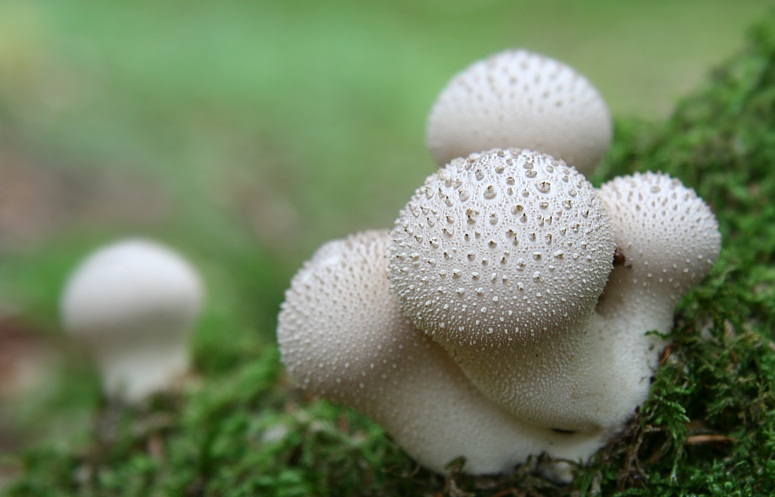
From above, the earth is laid in a trench with a layer of 5 centimeters. Then we take the sowing mycelium of the raincoat and sow it evenly over the entire area directly into the trench. After that, the soil in the trench must be watered with a drip method and covered with branches. Periodically, you need to water the resulting bed with well, river or rain water to prevent the soil from drying out.A slight excess of moisture is allowed.
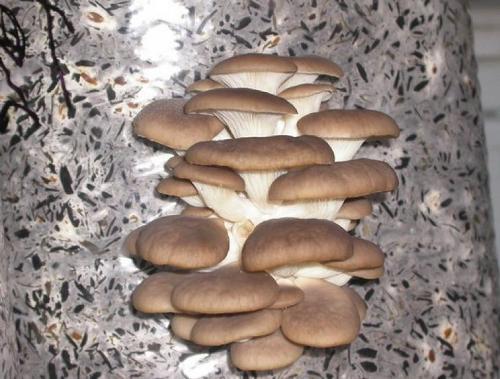
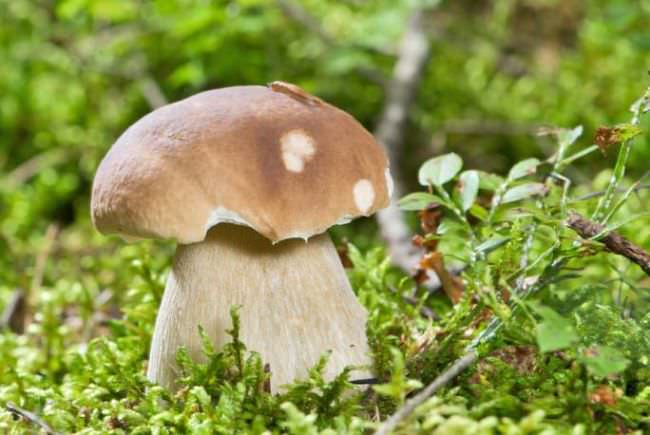
From forest mushrooms to garden mushrooms. An example of growing a porcini mushroom (boletus)

A shaded area under trees with an area of 2.5-3 m 2 is allocated for mushrooms, on which a small pit 30 centimeters deep is dug. Fallen leaves (a layer of 10 centimeters), grass, dust or tree bark are poured at the bottom, and then the same layer of dung or earth from under the trees.

